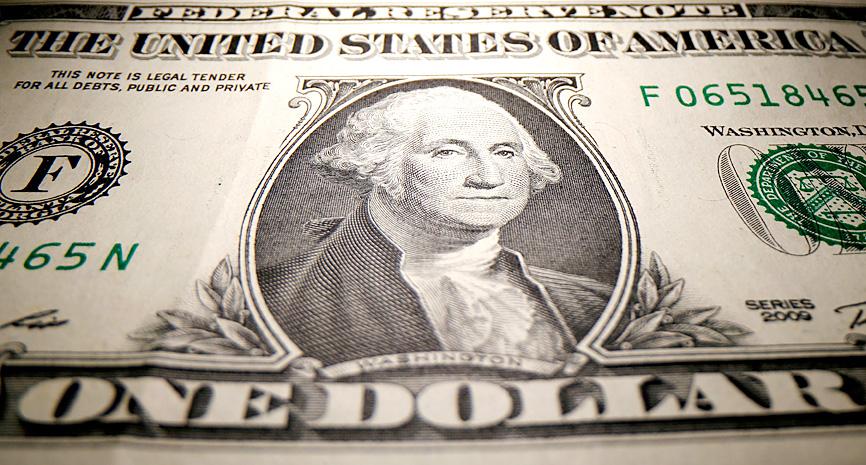The US dollar on Friday consolidated gains and posted its biggest weekly rise in seven months as markets priced in a year ahead of aggressive hikes in US interest rates.
Money markets priced in a 28.5 basis-point interest rate hike in March last year and as many as 119.5 basis points in cumulative increases by year’s end as the US dollar steadily rose in a week highlighted by a more hawkish tone from the US Federal Reserve.
The US dollar index rose a scant 0.04 percent to 97.22. The index, which measures the US dollar’s value against other major currencies, rose 1.65 percent for the week, its biggest weekly gain since June. It shot above 97 for the first time since July 2020.

Photo: Reuters
“I look for some consolidation, but nothing to say that the dollar’s up move is over,” Bannockburn Global Forex chief market strategist Marc Chandler said.
US labor costs increased in the fourth quarter, but less than expected, the US Department of Labor said.
The Employment Cost Index (ECI), the broadest measure of labor costs, rose 1.0 percent after increasing 1.3 percent a quarter earlier.
Economists polled by Reuters had forecast a 1.2 percent advance in the ECI, widely viewed as one of the better measures of labor market slack and a predictor of core inflation.
“The Employment Cost Index, which [Fed Chairman Jerome] Powell has referred to specifically, was a bit softer than expected, and has spurred some position adjusting ahead of the weekend,” Chandler said.
US Treasury yields eased, with 10-year yields falling to about 1.77 percent for the day, well below two-year highs of nearly 1.9 percent hit on Monday.
The two-year Treasury yield, which often moves in step with rate expectations, slid 2.8 basis points to 1.164 percent, but was still much higher for the week.
Major currencies drifted sideways in Asian trading before Lunar New Year holidays next week even though US yields were marginally higher.
The New Taiwan dollar declined against US dollar on Friday, losing NT$0.022 to close at NT$27.828, down 0.45 percent from NT$27.702 a week earlier.
However, the NT dollar soared 2.02 percent against the greenback in the Year of the Ox due to Taiwan’s robust export performance, the central bank said.
Friday was the last trading session for the year on the lunar calendar.
The euro nursed losses on Friday with the single currency little changed at US$1.1143, a bit up from Thursday’s 20-month low of US$1.1131.
The yen rose 0.14 percent to ¥115.21 per US dollar.
Additional reporting by CNA, with staff writer

SEEKING CLARITY: Washington should not adopt measures that create uncertainties for ‘existing semiconductor investments,’ TSMC said referring to its US$165 billion in the US Taiwan Semiconductor Manufacturing Co (TSMC, 台積電) told the US that any future tariffs on Taiwanese semiconductors could reduce demand for chips and derail its pledge to increase its investment in Arizona. “New import restrictions could jeopardize current US leadership in the competitive technology industry and create uncertainties for many committed semiconductor capital projects in the US, including TSMC Arizona’s significant investment plan in Phoenix,” the chipmaker wrote in a letter to the US Department of Commerce. TSMC issued the warning in response to a solicitation for comments by the department on a possible tariff on semiconductor imports by US President Donald Trump’s

The government has launched a three-pronged strategy to attract local and international talent, aiming to position Taiwan as a new global hub following Nvidia Corp’s announcement that it has chosen Taipei as the site of its Taiwan headquarters. Nvidia cofounder and CEO Jensen Huang (黃仁勳) on Monday last week announced during his keynote speech at the Computex trade show in Taipei that the Nvidia Constellation, the company’s planned Taiwan headquarters, would be located in the Beitou-Shilin Technology Park (北投士林科技園區) in Taipei. Huang’s decision to establish a base in Taiwan is “primarily due to Taiwan’s talent pool and its strength in the semiconductor

An earnings report from semiconductor giant and artificial intelligence (AI) bellwether Nvidia Corp takes center stage for Wall Street this week, as stocks hit a speed bump of worries over US federal deficits driving up Treasury yields. US equities pulled back last week after a torrid rally, as investors turned their attention to tax and spending legislation poised to swell the US government’s US$36 trillion in debt. Long-dated US Treasury yields rose amid the fiscal worries, with the 30-year yield topping 5 percent and hitting its highest level since late 2023. Stocks were dealt another blow on Friday when US President Donald

UNCERTAINTY: Investors remain worried that trade negotiations with Washington could go poorly, given Trump’s inconsistency on tariffs in his second term, experts said The consumer confidence index this month fell for a ninth consecutive month to its lowest level in 13 months, as global trade uncertainties and tariff risks cloud Taiwan’s economic outlook, a survey released yesterday by National Central University found. The biggest decline came from the timing for stock investments, which plunged 11.82 points to 26.82, underscoring bleak investor confidence, it said. “Although the TAIEX reclaimed the 21,000-point mark after the US and China agreed to bury the hatchet for 90 days, investors remain worried that the situation would turn sour later,” said Dachrahn Wu (吳大任), director of the university’s Research Center for